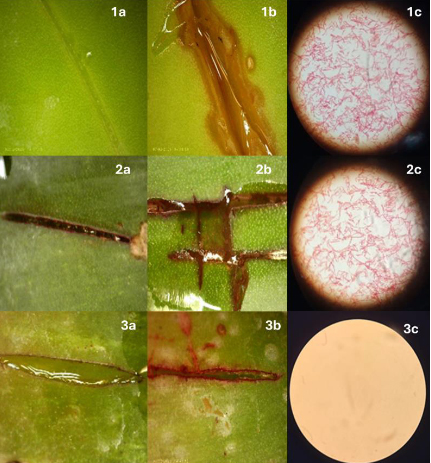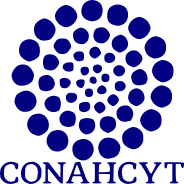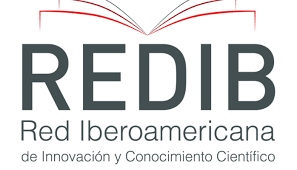In vitro evaluation of green synthesis nanoparticles and other biorational methods for the control of Pectobacterium carotovorum in Agave cupreata
DOI:
https://doi.org/10.18387/polibotanica.59.13Keywords:
Pectobacterium carotovorum, soft rot, biorational methods, AsA-AgNPs, AsB-AgNPs, Agave cupreata.Abstract
The Agave genus has cultural, social and economic importance due to its uses, highlighting the production of alcoholic beverages such as mezcal. One of the main species used for this purpose is Agave cupreata. Among the phytosanitary problems that limit its cultivation, is the soft rot of the bud caused by the bacterium Pectobacterium carotovorum, which causes losses of up to 157,088 liters of mezcal per year. The indiscriminate use of agrochemicals for its control leads to the degradation of ecosystems and the genetic resistance of pathogens. This work proposes the alternative use of biorational treatments such as the application of nanoparticulate systems (AsA-AgNPs, AsB-AgNPs), synthesized with Agave salmiana extracts and antagonists such as Bacillus subtilis and Trichoderma lignorum, comparing them with the bactericidal action of a commercial product (Agry-gent® Plus 800). The in vitro effect of three concentrations of these treatments in dual cultures was evaluated for their effect on the control of P. carotovorum, under a trifactorial arrangement with completely random distribution and three repetitions. The statistical analysis revealed that the concentration of 0.06 mg/mL of AsA-AgNPs, followed by 0.008 mg/mL of Agry-gent® Plus 800 were significantly the most effective in the control of the phytopathogenic bacteria.
References
Aquino, B. T., Ruíz, V. J., y Iparraguirre, C, M., 2006. Control biológico del picudo negro (Scyphophorus interstitialis Gyllenhal) con nematodos y hongos entomopatógenos en agave en Oaxaca, México. Revista UDO Agrícola. 6(1). pp. 92-101.https://dialnet.unirioja.es/servlet/articulo?codigo=2252800
Aquino-Bolaños, T., Sánchez-García, J.A., Ortíz-Hernández, Y. D., Hernández-Cruz, J., and Cortés-Martínez, C.I., 2020. Carrier and vector of Pectobacterium carotovorum subsp. carotovorum and its handling through a base of entomopathogenic fungi in Agave sp. The Florida Entomologist. 103(2). pp. 243-246.https://www.jstor.org/stable/48610666
Amaya, G., Beltrán, M. y Alfonzo, N., 2021. Pectobacterium carotovorum: agente fitopatógeno causante de la pudrición blanda en la papa (Solanum tuberosum). Ciencia y Tecnología Agropecuaria. 22(2). pp. 1-29.https://doi.org/10.21930/rcta.vol22_num2_art:1710
Anandalakshmi, K. y J. Venugobal., 2017. Green Synthesis and Characterization of Silver Nanoparticles Using Vitex negundo (Karu Nochchi) Leaf Extract and its Antibacterial Activity., Medicinal Chemistry. 07(07). pp. 218-225. https: //bit.ly/3xddb5u.
Avendaño-Arrazate, CH., Iracheta-Donjuan, L., Gódinez-Aguilar, J.C., López-Gómez, P., Barrios-Ayala, A. 2014. Caracterización morfológica de Agave cupreata, especie endémica de México. Phyton (Buenos Aires). 84(1). pp. 148-162.http://www.scielo.org.ar/scielo.php?pid=S185156572015000100022&script=sci_arttext&tlng=es
Bashir, A., Farah, S., Shumaila, B., Ibrar, K. and Sadiq, A., 2016. Green synthesis, characterisation and biological evaluation of AgNPs using Agave americana, Mentha spicata and Mangifera indica aqueous leaves extract, Mentha spicata and Mangifera indica. IET Nanobiotechnology, 10(5), pp. 281-287.https://doi.org/10.1049/iet-nbt.2015.0053.
Chengzhu, L. Z., Li, Y. and Tjong, S, C., 2019. Bactericidal and Cytotoxic Properties of Silver Nanoparticles. Molecular Sciences. 20(2). pp. 449. https://doi.org/10.3390/ijms20020449
Cruz-Monterrosa, R., Reséndiz-Cruz, V., Landa-Salgado, P., Jiménez-Guzmán, J., Díaz-Ramírez, M., Miranda-De La Lama, G., Rayas-Amor, A.A. y García-Garibay J.M., 2017. Nanotecnología en la industria alimentaria. Nanopartículas usadas en la Conservación de la carne. Agro Productividad 10(10). Pp. 39-46.https://mail.revista-agroproductividad.org/index.php/agroproductividad/article/view/90/83.
Cuervo-Parra, J, A., Pérez-España, V, H., Pérez, Pablo, A.L., Morales-Ovando, M, A., Arce-Cervantes, O., 2019. Scyphophorus acupunctatus (Coleoptera: Dryophthoridae): A Weevil Threatening the Production of Agave in Mexico. BioOne Complete. 102(1). pp. 1-9.https://doi.org/10.1653/024.102.0101
Fernández, B., 2017. Estudio de las aplicaciones biomédicas de las nanopartículas de plata., Tesis de grado. Universidad de Sevilla.https://bit.ly/3sCKStO.
García-Martínez, D. C., Vázquez, A., Ayala-Escobar,V., Nava-Díaz, C. y Aranda-Ocampo, S., 2022. Bacillus y Pseudomonas fluorescentes de la rizosfera de agaves silvestres antagonistas contra bacterias pectinolíticas. Ecosistemas y Recursos Agropecuarios. 9(1), pp.1-13.https://doi.org/10.19136/era.a9n1.3177
González-Pedroza, M, G., Argueta-Figueroa, L., García-Contreras, R., Jiménez-Martínez,Y., Martínez-Martínez, E., Navarro-Marchal S. A., Marchal, J. A.,Morales-Luckie, R.A y Boulaiz.H., 2021. Silver Nanoparticles from Annona muricata Peel and Leaf Extracts as a Potential Potent, Biocompatible and Low Cost Antitumor Tool. Nanomaterials. 11(5). pp. 1273https://doi.org/10.3390/nano11051273.
Guerrero, R., Mónaco, C., Stocco, M., Rolleri, J. y Guerrero, N., 2017. Aplicación de Trichoderma harzianum para el control del cáncer bacteriano (Clavibacter michiganensis subsp. michiganensis) del tomate (Lycopersicum esculentum Mill.) en invernadero. Revista Amazónica Ciencia y Tecnología. 6 (9), pp. 230-243.http://sedici.unlp.edu.ar/handle/10915/109287
Hernández, L.J. de J., 2018. Los Mezcales Mexicanos: la importancia de su protección como patrimonio social. ILHA. 20(2). pp. 179-205.http://dx.doi.org/10.5007/2175-8034.2018v20n2p179
Icochea, T.A. (1997). Enfermedades fungosas y bacterianas de raíces y tubérculos andinos. International PotatoCenter.https://books.google.com.mx/books?hl=es&lr=&id=aWqVf5C7qoC&oi=fnd&pg=PA1&dq=Enfermedades+Fungosas+y+Bacterianas+de+Ra%C3%ADces+y++Tub%C3%A9rculos+Andino&ots=qykjgiqjq&sig=9J18ttLgYRB5NORRyTAdIuyxxXw&redir_esc=y#v=onepage&q=Enfermedades%20Fungosas%20y%20Bacterianas%20de%20Ra%C3%ADces%20y%20%20Tub%C3%A9rculos%20Andino&f=false
Jiménez-Hidalgo. I.,Virgen-Calleros. G., Martínez-de la Vega. O., Vandemark. G y Olalde-Portugal. V., 2004. Identification and characterisation of bacteria causing soft- rot in Agave tequilana. European Journal of plant Pathology. vol. 110. pp. 317-331.https://link.springer.com/article/10.1023/B:EJPP.0000019791.81935.6d
Ledezma, A., Romero, J., Hernández, M., Moggio, I., Arias, E y Padrón, G., 2014. Síntesis biomimética de nanopartículas de plata utilizando extracto acuoso de nopal (Opuntia sp.) y su electrohilado polimérico., Sociedad Mexicana de Ciencia y Tecnología de Superficies y Materiales. 27(4), pp.133-140.https://www.scielo.org.mx/scielo.php?script=sci_arttext&pid=S1665-35212014000400133
González-Pérez, E., Ángeles-Núñez, J. G., 2020. Antagonismo de Trichoderma harzianum contra la fusariosis del garbanzo y su efecto biofertilizante. Revista Mexicana de Ciencias Agrícolas. 11(5), pp. 1135-1147.https://doi.org/10.29312/remexca.v11i5.2325
Monge, M., 2009. Nanopartículas de plata métodos de síntesis en disolución y propiedades bactericidas. Tesis de Universidad de La Rioja. pp. 33-41.https://dialnet.unirioja.es/servlet/articulo?codigo=2931286.
Nair, L. y Laurencin, C., 2007. Silver Nanoparticles: Synthesis and Therapeutic Applications., Journal of Biomedical Nanotechnology. pp. 301-316.https://bit.ly/3sCZd9C.
Nacimba, N, G, A., Félix, D, A, L y Santafé, D, C., 2018. Tratamiento de desechos orgánicos empleando microorganismoscelulíticos.http://scielo.senescyt.gob.ec/scielo.php?script=sci_arttext&pid=S260284842018000100030
Olvera-Vargas, L. A., Pardo-Núñez, J. Y Aguilar-Rivera, N., 2022. Detección de Agave angustifoliay Agave cupreata con técnicas geomáticas en Guerrero, México. Cienc. Tecnol. Agropecuaria. 23(2).https://doi.org/10.21930/rcta.vol23_num2_art:2241
Pardo, L., Arias, J. y Molleda, P., 2022. Elaboración de nanopartículas de plata sintetizadas a partir de extracto de hojas de romero (Rosmarinus officinalis l.) y su uso como conservante. La granja: Revista de Ciencias de la Vida. 35(1), pp. 45-58.https://doi.org/10.17163/lgr.n35.2022.04
Rashid, M., Chowdhury, M. S. M. and Sultana, N., 2013. In-vitro Screening of some Chemicals and Biocontrol Agents against Erwinia carotovora subsp. carotovora, the Causal Agent of Soft Rot of Potato (Solanum tuberosum). The Agriculturists. 11(2), pp. 1-9.https://doi.org/10.3329/agric.v11i2.17480
Rojas-Avelizapa , N. G., Regalado- Infante, P. E., Dávila Lezama, M, del R., Llarena, R. C. y Rojas-Avelizapa, L. I., 2020. Actividad antimicrobiana de nanopartículas de plata contra bacterias fitopatógenas. Revista Biológico Agropecuaria Tuxpan. 8(2). pp. 1-7.https://doi.org/10.47808/revistabioagro.v8i2.173
SAGARPA., 2017., Ficha técnica pudrición blanda del cogollo del agave, Pectobacterium carotovorum subsp. carotovorum (Jones) Waldee, 1975.https://www.gob.mx/cms/uploads/attachment/file/244028/Ficha_T_cnica_Pectobacterium_carotovorum_en_agave_Versi_n_FINAL.pdf
Santos, P.A, y Barrios, L. N., 2022. Aplicación de pigmentos producidos por Streptomyces coelicolor en la síntesis de nanopartículas de plata con actividad antimicrobiana. Hechos Microbiológicos.13(1), pp. 37-46.https://doi.org/10.17533/udea.hm.v13n1a04
Solís-Aguilar, J. F., González-Hernández, H., Leyva-Vázquez, J. L., Equihua-Martínez, A., Flores-Mendoza, F.J. y Ángel Martínez-Garza, Á., 2001. Scyphophorus acupunctatus Gyllenhal, plaga del agave tequilero en Jalisco, México. Agrociencia. 35(6). pp. 663- 670.https://www.redalyc.org/pdf/302/30200609.pdf
Solís, K. D., Palacios, J. E., Toledano, Y., Garibo, A y Garibo, D., 2019. Síntesis de nanopartículas de plata a partir del extracto acuoso de Annona muricata y su efecto antimicrobiano. Academia Journals.https://www.researchgate.net/profile/dianagaribo/publication/352196984_sintesis_de_nanoparticulas_de_plata_a_partir_del_extracto_acuoso_annona_muricata_y_su_efecto_antimicrobiano/links/60be5291a6fdcc22eae88cc5/sintesis-de-nanoparticulas-de-plata-a-partir-del-extracto-acuoso-annona-muricata-y-su-efecto-antimicrobiano.pdf
Villamizar, G. y Monroy, P., 2015. Uso de Nanopartículas de plata en el control de microorganismos patógenos presentes en alimentos. Limentech Ciencia Y Tecnología Alimentaria 13(1). pp. 54-59.https://ojs.unipamplona.edu.co/ojsviceinves/index.php/alimen/article/view/1607

Downloads
Published
Issue
Section
License

Polibotánica by Departamento de Botánica de la Escuela Nacional de Ciencias Biológicas del Instituto Politécnico Nacional se distribuye bajo una Licencia Creative Commons Atribución-NoComercial-CompartirIgual 4.0 Internacional.



















